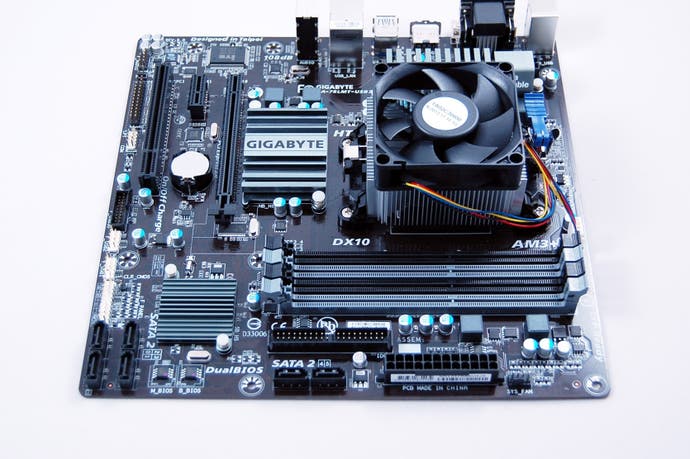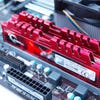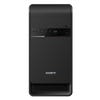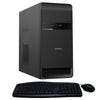The next-gen Digital Foundry PC: chasing the 1080p60 dream
A sub-£500 PC that comprehensively bests Xbox One and PS4. Can it be done?
It's often been said that both next-gen consoles are effectively based on mid-range PC technology, and as our recent tests indicate, matching or even exceeding current Xbox One or PS4 performance with modest PC components doesn't seem to be too difficult. But can we go one better? Can we build a PC that provides a quantifiably better, truly transformative experience? And can we do it at with a competitive budget?
We've had some experience in constructing affordable games PCs. Back in June 2012, we put together the Digital Foundry PC - a £300 piece of hardware with around 4x the power of Xbox 360 and PlayStation 3. We had a lot of fun with that kit, but across the months, its weaknesses became steadily more apparent. To put it simply, a dual-core CPU wouldn't cut it for 60fps gaming - not even at 720p, though 1080p30 was mostly fine.
The new Digital Foundry PC acknowledges that an improved balance between CPU and GPU power is required, at the same time recognising that gaming development is moving away from fast single-core performance and gravitating more towards many cores operating at lower frequencies. Our new hardware also factors in the leap in GPU performance required to keep pace with the power of the new consoles, but it's also based on keeping to a reasonable budget. Right now, nothing is going to beat the power offered by PlayStation 4 at £350, so we've increased the budget - the aim being to affect a truly transformative gameplay experience.
It's an acceptable trade. While the cost of the console is a relatively low base cost, the PC has no service subscription to maintain and software will also be cheaper. Consider the recent release of Thief: on Xbox One and PS4, the game costs £47 on Amazon, while the PC edition is just £22 on the same site. It's no real secret that PC gaming is substantially cheaper, so we have no problems re-investing a little of that cash into hardware that should - in theory at least - offer up a higher-quality gameplay experience. With that out of the way, let's talk components and build costs.
The left-field CPU choice: AMD FX-6300
Intel is the obvious choice for PC gaming, right? Well, we've gone for AMD with our set-up. Next-gen console game development is based on six available CPU cores clocked at 1.6GHz/1.75GHz (PS4 and Xbox One respectively), so we should expect all major games to be multi-core aware going forward - and if they're not, they're really going to suffer. In the here and now, Intel's dual-core i3 is still competitive, but we suspect that games will be designed with many-core architectures in mind going forward and the FX-6300 offers excellent value at just over £80.
It features six available cores at 3.5GHz (boosting to 4GHz when thermal headroom is available) and on top of the clock-speed advantages over next-gen console, it has higher IPC (instructions per clock) than the Jaguar cores in the PS4 and Xbox One. In theory at least, there should be plenty of power here - plus there's an upgrade path to the eight-core AMD chips, the FX-8320 and the FX-8350. The former is an interesting alternative choice at the initial build stage - it matches the FX-6300's clock speeds, but it offers an additional two cores for around £25 more.
We're taking a bit of a punt here - an Intel quad is the more obvious choice, but the cheapest option is the Core i5 4430 at around £140. That leaves the Core i3 4130, which is price comparable to the FX-6300, but it is a dual-core part. In many existing games, it'll outperform our chosen AMD part, but we believe in the many-core future, so we're sticking with the FX-6300 as our choice.
Graphics tech: Radeon R9 270/270X or GeForce GTX 760?
With the graphics card, things get interesting. For our money, there is one clear winner out there right now in terms of price vs performance - the Radeon R9 270. Available for as little as £120 on occasion, it's effectively a rebrand of AMD's stalwart Radeon HD 7870. And by happy coincidence, it's very similar to the PS4's GPU, boosted by two additional compute units and a 175MHz boost to clock-speed.
The vast majority of R9 270s should also overclock easily to R9 270X levels, increasing the frequency differential to an impressive 30 per cent over the PS4. If you're not interested in overclocking, the R9 270X itself is a good deal - and costs just £25 more. However, generally speaking, the advantage offered by the 270X over its cheaper sibling is a mere five to seven per cent - and the overclock is really simple and bridges the gap completely. The remarkable reality is that AMD effectively launched a spoiler product that made its own more expensive GPU a touch redundant for anyone other than hardcore overclockers.
"The R9 270 represents stunning value, but it doesn't quite offer up the leap in graphics power we are after, so the more expensive GeForce GTX 760 is our choice."
But would the same GPU architecture as the PS4 be able to provide the transformative experience we're looking for? We ran a quick test. On a base level, we wanted our PC to run Battlefield 4 at 1080p on high settings with higher frame-rates than the 900p PS4 game, ideally hitting 60fps. We chose a known BF4 bottleneck from the initial Baku level and compared the R9 270/270X with PS4, and then with the logical next step up in GPU power: Nvidia's GeForce GTX 760.
The results are clear enough. The 270/270X mostly delivers the 1080p60 experience we crave, but under stress both cards fall behind the PS4 performance. Bearing in mind that the AMD cards are still delivering a massive 44 per cent boost in resolution over the PS4 game, it's clear that they remain the sweet spot in terms of price vs performance. However, the experience is just that much smoother and better on the more expensive GTX 760. And factoring in its support for in-game Twitch streaming and ShadowPlay footage capture, along with other Nvidia-only tech (TXAA, G-Sync etc), that's the card we decided to go for.
Memory, motherboard, case and power supply
Other elements of the build also proved interesting. The perceived wisdom is that you should aim for at least 8GB of DDR3 system memory (or higher), split across two 4GB modules. By running both together, you achieve dual-channel bandwidth, allowing data to pass more quickly from RAM to processor and beyond. However, in our testing, we saw no discernible difference between 4GB and 8GB in some games, with Battlefield 4 only dropping frames when the engine background-streamed new assets into memory. There's a potential £30 saving here if you went for just one 4GB RAM module, but for the sake of future-proofing, we do recommend two. Anything beyond 8GB seems to be overkill right now.
Motherboard-wise, the Gigabyte GA-78LMT-USB3 should do the job nicely. It's a small board that fits into a small form factor micro-ATX case, creating a machine that can easily slot into your living room if that's where you want to game. It's also notable in that we have four RAM slots, boosting upgrade potential, plus there are two USB 3.0 ports - something of a rarity on budget boards.
"Our chosen AM3+ platform doesn't offer any mini-ITX small form factor options, but micro-ATX boards are cheap and you can still build a living room friendly box."

That just leaves the case, hard drive and power supply - generic choices really that should be based on your budget, brand and desired form factor. We chose the cheapest 7200rpm hard drive we could find, in combination with the Gigabyte GZ-MA02 four-in-one, giving us a nice little case, a decent 450W power supply, keyboard and mouse for just £55. However, the micro-ATX form factor we have chosen for the motherboard does mean that you can make a relatively small Steam Machine-style PC if you want - for example, you'll find that a mATX PC in a Silverstone SG03, pictured below, looks quite at home in our selection of gaming machines, if you can afford to spend £60 on a case alone.
With our parts selected and the PC built, the next order of business is the operating system. We chose Windows 7 64-bit for our set-up, mostly because licenses can be acquired in the £40-£50 range now on eBay, and despite Windows 8 improving significantly since its launch, there's only one game that utilises its more advanced form of DirectX - Battlefield 4.
Let the games begin: Battlefield 4
For all its problems, DICE's combat epic remains the definitive technological workout for both PC and next-gen consoles, and the benchmark for comparison. Xbox One and PS4 operate at native resolutions of 720p and 900p respectively, handing in a single-player experience that targets 60fps but falls a little short, while multiplayer sees frame-rates drop still further.
Our internal benchmark for the success of our PC build involved hitting 1080p on the high-quality preset - a substantial resolution increase over the preferred PlayStation 4 version, with improved image quality. Not only that, we really wanted 60fps too, in both single-player and multiplayer - a tall order for sure.
First up, let's match up the new DFPC with Xbox One and PlayStation 4 in our campaign suite. This involves a series of action clips from the initial Baku stage, backed up by additional analysis of the classic aircraft carrier battle from the South China Seas level.
The results show that we achieve a comprehensive improvement over the PlayStation 4 standard. We keep our 44 per cent resolution increase, and frame-rates exceed the Sony console, usually hitting our preferred 60fps, though we do see drops in some of the more battering set-pieces.
But it's in multiplayer where the advantage truly becomes evident. In 64-player battle, we were delighted to enjoy a mostly locked 60fps across a whole afternoon's play - the only notable drop being a sustained 45fps when we climbed a mountain and looked down upon a major skirmish unfolding before our eyes involving many players. Thankfully, this was the exception, not the norm, but it was perhaps the most spectacular moment in gaming we've enjoyed this year and testament to the ambition of the game.
We would have preferred to have spent more time exploring the many graphical options BF4 has to offer (we suspect we could have pushed texture resolution to ultra with little impact to performance) but this brings us back to a real issue we have with PC gaming in general - a lack of transparency on what the presets actually do and how much GPU resource we'd save (or spend) by tweaking them. As we mentioned last week, PC really does need a more thoughtful approach to calibrating gameplay to match system resources.
Can the new DFPC beat PlayStation 4 on all games?
Next up, a compilation of other cross-platform games running on the new Digital Foundry PC: specifically, Lego Marvel Super Heroes, Call of Duty: Ghosts, Assassin's Creed 4 and Need for Speed: Rivals.
We start off with a promising beginning. Lego Marvel Super Heroes clearly has no problem at all rendering at 1080p60 on the GTX 760, with all settings ramped up to the maximum. This offers us double the performance of the console versions, and again, fulfils the criteria for a truly transformative gameplay experience. Visually, we're looking at a game equivalent to the PS4 and Xbox One releases, though curiously we see no screen-space ambient occlusion (SSAO) - the only blemish to the PC version's visual make-up. The only downer here is a rather unfortunate background streaming issue that occasionally impacts performance - as you can see in the video.
Little need be said about Need for Speed: Rivals - by default it's locked to 30fps, and we comfortably ran the game at ultra settings, matching PS4 on all counts, with small image quality improvements over Xbox One. We tried the frame-rate unlock command line tricks detailed in the Face-Off, and while they worked in breaking the 30fps cap, performance lurched between 45fps and 60fps. Not good at all, so we'll stick to 30fps instead - and a more console-style experience. It's still a great game but we got the same results with the much cheaper GTX 750 Ti and the Radeon R7 260X. Also, we note that the frame-pacing issues (30fps, but with uneven delivery of new images) have now been fixed on console, as this video demonstrates, but PC remains untouched, which is a little disappointing.
"We had mixed results hitting our 1080p60 target in key games, despite our Battlefield 4 results. In some cases, the PC is still receiving unoptimised releases with real performance issues."
With Assassin's Creed 4, again we hit the 30fps wall. The PC version of the game employs a hard v-sync double-buffer, meaning that given the horsepower, it'll run at 60fps, but should frames consistently render at over the magical 16.67ms budget, 30fps is all you'll get. In effect, we get another unavoidable frame-rate cap on the DFPC, but there's plenty of leeway in ramping up many settings to the max, though we retain sanity in the key areas of anti-aliasing and shadows. In short, a visually richer game over console, but not a radically improved game. You'll note from our tests last week that even a 4.3GHz Core i7 quad-core processor with top-end Radeon R9 290X still cannot achieve a fully locked 1080p60, suggesting optimisation issues.
The less said about Call of Duty: Ghosts the better. We couldn't achieve anything like a locked 1080p60 (again, even the i7/290X combo didn't work out well), and while image quality was improved over console, the frame-rate variations were harsh, killing the unique handshake that defines the essence of the series. What particularly shocked us was Infinity Ward's take on "image quality" - the setting here is a resolution downscale, pure and simple. Select 1080p in the settings along with very low image quality, and you effectively get a 480p downscaled presentation (!) while on the other end of the scale, only "extra" actually renders at native 1080p (for the record, high appears to be 720p). It's proof-positive that high-end PC gamers aren't guaranteed a release that's automatically better than the console equivalents, even if you throw a huge amount of money at your set-up.
Tomb Raider: settings management vs console optimisation?
Finally, let's talk Tomb Raider - the only game that has seen an appreciable amount of extra development added for the console versions since the PC release last year. Here's where things get interesting, as new features have been introduced - specifically, additional environmental detail, physics-driven foliage and a revised version of the TressFX dynamic hair technology.
To achieve 1080p60 on PC, we need to pick our battles. The initial form of TressFX is simply too much of a load on the system, while shadows - once again - prove to be a major drain on resources with no appreciable gain in overall quality should you drop down from ultra to high. Here are a couple of screenshots showing how we chose our settings. Again, we really wish there was some kind of real-time graphics calibration system - or at least some kind of indication of how much GPU time we'd save by reducing a specific setting.
The loss of a showcase piece of technology like TressFX is a disappointment (though as you can see from the shots above, the overall impact in gameplay is minimal, physics and lighting don't seem to look right and the frame-rate hit is enormous) but on the plus side, we are running the game at a higher sustained frame-rate overall compared to the PlayStation 4 version, while we also get to enjoy additional features not seen on console, such as tessellation and a more liberally employed motion blur.
But the question is, are we getting a substantially improved experience over the console versions - PS4, specifically? We're not fully convinced. Sony's console is clearly handing in a great experience here. Now, we could just be seeing the benefits of additional development time, leaving the PC version behind in some respects. Equally, it may well be the case that console-specific optimisation could cause problems for PC in the future.
But there's one takeaway we simply cannot ignore. PS4's variable frame-rate appears to be mostly down to TressFX, which clearly incurs a large GPU hit - especially in close-up. The question is, would you - as a player - trade the hair tech for a much higher frame-rate? That's a choice you can make on PC, but you can't on console, and a fundamental strength of the platform: the ability to tailor the experience to your own personal preferences.
Should we have chosen the R9 270? What about Mantle?
Reaching the end of our testing, we couldn't help but wonder whether our investment in the GTX 760 paid off to the degree that we hoped. The cheapest we've ever seen the GTX 760 is £170, while the R9 270 can often be seen on sale for £120-£130 - a £40 to £50 saving. We took a chance on the GTX 760 owing to the improved results in Battlefield 4, but performance was very close in all of the other games we tested.
Our advice? If you're looking to future-proof to an appreciable degree, the GTX 760 will come good. However, if you're looking for the current best in price vs performance, grab an R9 270 on sale, ramp up PowerTune as much as you can in AMD's Catalyst control panel, then increase core frequency to 1050MHz to match the 270X. It's effectively a free upgrade and should work just fine unless you are extremely unlucky and get an underperforming chip. We find this unlikely, as most 270s are overclocked to a certain degree out of the box anyway.
The elephant in the room is AMD's Mantle API. Why didn't we compare the R9 270(X) with the GTX 760 with the new API in effect? Well, the truth is that massive issues kicked in with the Mantle version with v-sync engaged during our initial testing phase. Our personal gaming requirements demand v-sync, with something approaching a locked 60fps - it's our gaming preference and the closest match to the benchmark set by PlayStation 4. However, as we concluded this article, we went back to BF4 with the latest AMD beta drivers and noted some extremely promising improvements. We're not there yet - there are still some really poor frame-rate drops with v-sync engaged - but Mantle is looking promising, to the point where key bottlenecks are being resolved and the 270X hands in GTX 760-level performance. We plan to investigate Mantle across a range of systems soon, having done some work on integrating DICE's frame-rate tracking systems into our tools, but what's clear is that current evaluations of Mantle using the traditional average frame-rate technique don't tell the full story, as the second shot in the gallery below illustrates rather well.
"Mantle is clearly a work in progress, but when it's running properly, the advantages for the Digital Foundry PC are clear to see, with the Radeon R9 270X matching the more expensive GTX 760."
The new Digital Foundry PC and the 1080p60 dream: final words
On a technological level at least, the reality is that everyone is now a PC gamer - even if you own a PlayStation 4 or Xbox One. The convergence in technology in combination with the fact that Microsoft and Sony are unwilling to make crippling losses on their next-gen consoles has created an interesting scenario - gamers can put together categorically more powerful PC gaming hardware at a very competitive price. Not only that, but the nature of Moore's Law and the immensely competitive PC hardware market will only see the value proposition of the platform rise still further. What remains to be seen is the extent to which the fixed platform architecture of the consoles can be leveraged by developers for increased performance.
In the here and now, we're wondering whether we did achieve a truly transformative gameplay experience over PlayStation 4 and Xbox One? In a number of cases, we categorically did not. Need for Speed: Rivals boasts only minor refinements over the console versions and was pegged to the same 30fps, while Call of Duty: Ghosts is a genuinely poor experience on PC. With Assassin's Creed 4, we had a great deal of leeway in exploring higher-quality visual settings, but again, the feeling of the game was very similar. On Tomb Raider, we could beat the 1080p performance of the PS4 game, but only with careful settings management - and the disabling of the showcase TressFX technology.
In short, there's no magic bullet that guarantees you a locked 1080p60 experience. Even with settings pared back, both of these titles failed to remain solid even when we ran them on an overclocked Core i7-3770K at 4.3GHz matched with a Radeon R9 290X. While we expected as much from COD - it has some performance issues on console, after all - we were very surprised to find that AC4 had optimisation issues that could bring the frame-rate crashing down from 60fps even on high-end rigs, while virtually any gaming PC with even a modest GPU can hand in a console-style 30fps with no problems whatsoever.
"We're very happy with the amount of power we squeezed out of our budget, with BF4 clearly the highlight. But the PS4 in particular has a great hardware balance at an attractive price point."
Only two titles out of six demonstrated the enormous improvement we were after. With Lego Marvel Super Heroes, 60fps gaming (streaming hiccups aside) did everything we expected in making for a tangibly superior experience, while Battlefield 4 remained the best example of a game transformed: 1080p with just minor drops throughout the campaign, improved visual quality beyond resolution alone and a 60fps experience that extends into the multiplayer game. It's frankly remarkable.
However, PC elitists expecting a knockout blow against the consoles - PlayStation 4 in particular - may end up disappointed by our findings. The amount of power you're getting in a small form-factor box - complete with a substantial backing ecosystem - offers simply phenomenal value. And all of the games tested are first-gen efforts; clearly they will get better. The only question is whether future optimisations for console improve the PC experience, or whether we'll be reliant on PC brute-forcing its way to supremacy, as per the last generation.
But let's not forget the advantages the PC platform has to offer outside of the narrow 1080p head-to-head comparisons we've carried out here. Our sub-£500 computer opens up a lot of options not available to console owners - and the results can be hugely impressive. We had no problem running Need for Speed and AC4 at 2560x1440 at 30fps on the same quality settings, while Lego Marvel Super Heroes also ran at 2.5K at 60fps. On top of that, we have a route to stereo 3D on most games with Nvidia 3D Vision, plus there's G-Sync to factor in, not to mention the upcoming VR revolution, spearheaded by Oculus Rift. You won't be playing Uncharted or Halo on PC, but each platform has its own range of enviable exclusives - be they hardware or software.
Additional material by Thomas Morgan.






























